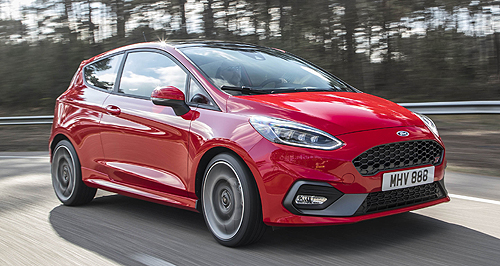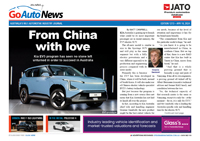Make / Model Search
Future models - Ford - FiestaFord drops regular Fiesta variants but ST lives onFiesta siesta: The non-performance Fiesta line-up will not be sold in seventh-generation form locally, but the door remains open for it to return in the future. Thai production refocus ends mainstream Ford Fiesta range as next ST is confirmedGallery Click to see larger images 17 Apr 2018 FORD Australia has confirmed that it will not import regular variants of the seventh-generation Fiesta light car from Germany after the previous model’s Thai production run ends in the next few months, but the high-performance ST flagship is set to return in the second quarter of next year. Doubt had been cast over the Fiesta’s future in Australia following the announcement in November 2016 that the new model would be built in Germany, but the Blue Oval’s local arm succumbed to a business case that was instead impacted by shrinking sales in the light-car segment. Speaking to GoAuto, Ford Australia product communications manager Damion Smy explained that shifting buyer preferences spelt the end for mainstream Fiesta variants. “Australians are obviously head over heels in love with SUVs,” he said. “We know that 2017 was the first time that passenger vehicles were outsold by SUVs, so we see there is opportunity in (small) SUVs, with EcoSport for example, longer term than (light cars), with Fiesta,” he said. In 2017, the overall light-car segment was down 11.3 per cent year on year, to 84,249 units, while the overall small-SUV segment was up 6.5 per cent, to 117,573 vehicles. Sales of the Fiesta took a significant hit last year, with 1550 examples sold to the end of 2017, representing a 43.1 per cent drop over the 2722 deliveries made in 2016. Comparatively, the EcoSport tallied 1364 sales last year, down 25.0 per cent on 2016. This effort meant the Fiesta placed 10th in the sub-$25,000 light-car segment in 2017, trailing the Hyundai Accent (17,578 units), Mazda2 (12,101), Toyota Yaris (11,226), Honda Jazz (7301) and Kia Rio (6852), among others. The Fiesta’s downward trajectory has continued in 2018, with 252 vehicles finding homes to the end of March, equating to a 49 per cent decline over the 494 examples sold during the same period last year. Alternatively, the EcoSport has totalled 237 deliveries in 2018, down 34.9 per cent. When asked if the change in sourcing from Thailand to Germany impacted the business case financially, Mr Smy indicated that the switch was not a factor. “As you’ve seen, we’ve shifted Focus production from Thailand to Germany, so it’s not a cost-saving exercise. It’s more that the market is looking at different vehicles … there is more opportunity elsewhere, and we need to run an astute business,” he said. However, Mr Smy did not rule out a return for regular Fiesta variants down the line, whether it be during the incoming seventh generation or in future iterations. “Fashions and trends and market cycles change, so we wouldn’t ever categorically rule out a particular vehicle – it depends on the way the market is going,” he said. “We’re fond of Fiesta, we are obviously very fond of the ST, and as the market dictates we’ll work to deliver products that Australians want, and in that sense we wouldn’t necessarily rule out expanding the range – should that be necessary.” As a result, the last mainstream examples of the sixth-generation Fiesta are expected to hit showrooms in the third quarter this year, with stock set to dry up in the months afterwards. Nevertheless, fans of the light car will see it live on locally in its most potent form, with the range-topping ST variant set to carry the Fiesta nameplate for the foreseeable future, but Ford Australia is yet to confirm if it will be offered in three- or five-door hatchback guise. “We’ve decided to keep the Fiesta ST hero because we know how that resonates with people who are into dynamic, fun-to-drive vehicles, and the current Fiesta ST has such a great reputation,” Mr Smy added. As previously reported, the latest ST is motivated by a 1.5-litre EcoBoost three-cylinder petrol engine that produces 149kW of power and 290Nm of torque, up 15kW and 50Nm over its German-built, four-pot predecessor. Exclusively sending drive to its front wheels via a six-speed manual gearbox, the ST can sprint from standstill to 100km/h in 6.7 seconds – matching its 147kW/320Nm Volkswagen Polo GTI and 147kW/260Nm Renault Clio RS Sport rivals that have four-cylinder power. The ST further takes bragging rights thanks to its claimed fuel consumption figure of 4.8 litres per 100 kilometres on the combined cycle test and carbon dioxide emissions of 114 grams per km. Its cylinder deactivation system and petrol particulate filter help to achieve these best-in-class results. Just like its Focus RS stablemate, the ST features three driving modes – Normal, Sport and Track – which allow the driver to adjust engine, exhaust, steering and stability control settings on the move. A torque vectoring system also features, helping to improve road-holding and reduce understeer by gently braking the inside front wheel during cornering. Furthermore, the ST is visually distinguished from regular Fiesta variants with its unique bodykit and 18-inch alloy wheels, while Recaro sports seats and a flat-bottom steering wheel are included inside. As with other Fiesta variants, the ST comes with an 8.0-inch touchscreen Sync3 infotainment system with Apple CarPlay and Android Auto support, while a Bang & Olufsen Play sound system is optional. While Ford Australia is keeping pricing under wraps for now, the current ST is priced from $27,490 before on-road costs, with the new model expected to still undercut the automatic-only, identically priced Polo GTI and Clio RS Sport pair ($30,990).  Read more26th of June 2017  Doubts surround future of Ford Fiesta in AustraliaFord Australia could be forced to make do without new-generation Fiesta light car27th of February 2017  Geneva show: Ford outs three-pot Fiesta STThird-gen Ford Fiesta ST debuts punchy three-pot turbo engine, world-first tech22nd of February 2017  Ford flashes Fiesta STTeaser video heralds Ford Fiesta ST reveal on February 245th of December 2016  Ford details European-spec FiestaCrossover, Vignale and diesels confirmed for Euro Fiesta, Aus versions unclear30th of November 2016  Ford springs Fiesta at European galaAustralia has to wait for latest Ford Fiesta previewed in European guise in Germany12th of August 2016  Ford to take next-gen Fiesta upmarket: reportNext Ford Fiesta to be more mature but unlikely to hit Australia until 20181st of March 2016  Geneva show: Ford tunes up Fiesta ST200Most powerful production Ford Fiesta ST to date lobs at Geneva showAll future models Alfa Romeo Alfa Romeo Abarth Abarth Alpine Alpine Alpina Alpina Audi Audi Aston Martin Aston Martin BMW BMW Bentley Bentley Chery Chery Brabham Brabham Chrysler Chrysler Chevrolet Chevrolet Cupra Cupra Citroen Citroen DS DS Dodge Dodge Fiat Fiat Ferrari Ferrari Foton Foton Ford Ford Great Wall Great Wall FPV FPV Haval Haval GWM GWM Honda Honda Holden Holden Hummer Hummer HSV HSV Infiniti Infiniti Hyundai Hyundai Jaguar Jaguar Isuzu Isuzu Kia Kia Jeep Jeep Land Rover Land Rover Lamborghini Lamborghini Lexus Lexus LDV LDV Mahindra Mahindra Lotus Lotus Mazda Mazda Maserati Maserati Mercedes-AMG Mercedes-AMG McLaren McLaren MG MG Mercedes-Benz Mercedes-Benz Mitsubishi Mitsubishi Mini Mini Opel Opel Nissan Nissan Peugeot Peugeot Pagani Pagani Proton Proton Porsche Porsche Renault Renault Ram Ram Rover Rover Rolls-Royce Rolls-Royce Skoda Skoda Saab Saab SsangYong SsangYong Smart Smart Suzuki Suzuki Subaru Subaru Toyota Toyota Tesla Tesla Volvo VolvoFiesta pricingMotor industry news |
Click to shareFord modelsResearch Ford All future models Alfa Romeo Alfa Romeo Abarth Abarth Alpine Alpine Alpina Alpina Audi Audi Aston Martin Aston Martin BMW BMW Bentley Bentley Chery Chery Brabham Brabham Chrysler Chrysler Chevrolet Chevrolet Cupra Cupra Citroen Citroen DS DS Dodge Dodge Fiat Fiat Ferrari Ferrari Foton Foton Ford Ford Great Wall Great Wall FPV FPV Haval Haval GWM GWM Honda Honda Holden Holden Hummer Hummer HSV HSV Infiniti Infiniti Hyundai Hyundai Jaguar Jaguar Isuzu Isuzu Kia Kia Jeep Jeep Land Rover Land Rover Lamborghini Lamborghini Lexus Lexus LDV LDV Mahindra Mahindra Lotus Lotus Mazda Mazda Maserati Maserati Mercedes-AMG Mercedes-AMG McLaren McLaren MG MG Mercedes-Benz Mercedes-Benz Mitsubishi Mitsubishi Mini Mini Opel Opel Nissan Nissan Peugeot Peugeot Pagani Pagani Proton Proton Porsche Porsche Renault Renault Ram Ram Rover Rover Rolls-Royce Rolls-Royce Skoda Skoda Saab Saab SsangYong SsangYong Smart Smart Suzuki Suzuki Subaru Subaru Toyota Toyota Tesla Tesla Volvo VolvoFiesta pricingMotor industry news |


























Facebook Twitter Instagram